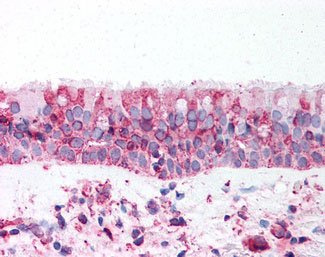TRPV4 Antibody (N-Terminus)
Rabbit Polyclonal Antibody
- SPECIFICATION
- CITATIONS
- PROTOCOLS
- BACKGROUND

Application
| IHC-P |
|---|---|
| Primary Accession | Q9HBA0 |
| Reactivity | Human |
| Host | Rabbit |
| Clonality | Polyclonal |
| Calculated MW | 98kDa |
| Dilution | IHC-P (2.5-5 µg/ml) |
| Gene ID | 59341 |
|---|---|
| Other Names | Transient receptor potential cation channel subfamily V member 4, TrpV4, Osm-9-like TRP channel 4, OTRPC4, Transient receptor potential protein 12, TRP12, Vanilloid receptor-like channel 2, Vanilloid receptor-like protein 2, VRL-2, Vanilloid receptor-related osmotically-activated channel, VR-OAC, TRPV4, VRL2, VROAC |
| Target/Specificity | Human TRPV4. BLAST analysis of the peptide immunogen showed no homology with other human proteins. |
| Reconstitution & Storage | Long term: -70°C; Short term: +4°C |
| Precautions | TRPV4 Antibody (N-Terminus) is for research use only and not for use in diagnostic or therapeutic procedures. |
| Name | TRPV4 |
|---|---|
| Synonyms | VRL2, VROAC |
| Function | Non-selective calcium permeant cation channel involved in osmotic sensitivity and mechanosensitivity (PubMed:16293632, PubMed:18826956, PubMed:18695040, PubMed:29899501, PubMed:22526352, PubMed:23136043). Activation by exposure to hypotonicity within the physiological range exhibits an outward rectification (PubMed:18826956, PubMed:18695040, PubMed:29899501). Also activated by heat, low pH, citrate and phorbol esters (PubMed:16293632, PubMed:18826956, PubMed:18695040, PubMed:25256292, PubMed:20037586, PubMed:21964574). Increase of intracellular Ca(2+) potentiates currents. Channel activity seems to be regulated by a calmodulin-dependent mechanism with a negative feedback mechanism (PubMed:12724311, PubMed:18826956). Promotes cell-cell junction formation in skin keratinocytes and plays an important role in the formation and/or maintenance of functional intercellular barriers (By similarity). Acts as a regulator of intracellular Ca(2+) in synoviocytes (PubMed:19759329). Plays an obligatory role as a molecular component in the nonselective cation channel activation induced by 4-alpha-phorbol 12,13-didecanoate and hypotonic stimulation in synoviocytes and also regulates production of IL-8 (PubMed:19759329). Together with PKD2, forms mechano- and thermosensitive channels in cilium (PubMed:18695040). Negatively regulates expression of PPARGC1A, UCP1, oxidative metabolism and respiration in adipocytes (By similarity). Regulates expression of chemokines and cytokines related to pro-inflammatory pathway in adipocytes (By similarity). Together with AQP5, controls regulatory volume decrease in salivary epithelial cells (By similarity). Required for normal development and maintenance of bone and cartilage (PubMed:26249260). In its inactive state, may sequester DDX3X at the plasma membrane. When activated, the interaction between both proteins is affected and DDX3X relocalizes to the nucleus (PubMed:29899501). In neurons of the central nervous system, could play a role in triggering voluntary water intake in response to increased sodium concentration in body fluid (By similarity). |
| Cellular Location | Cell membrane. Apical cell membrane; Multi-pass membrane protein. Cell junction, adherens junction {ECO:0000250|UniProtKB:Q9EPK8}. Cell projection, cilium. Note=Assembly of the putative homotetramer occurs primarily in the endoplasmic reticulum (PubMed:16293632, PubMed:20037587, PubMed:20037588). Localization to the cell membrane is inhibited by WNK kinases (WNK1, WNK2, WNK3 or WNK4) in a kinase-independent mechanism (PubMed:16403833) [Isoform 5]: Cell membrane [Isoform 4]: Endoplasmic reticulum |
| Tissue Location | Found in the synoviocytes from patients with (RA) and without (CTR) rheumatoid arthritis (at protein level) |
| Volume | 50 µl |

Thousands of laboratories across the world have published research that depended on the performance of antibodies from Abcepta to advance their research. Check out links to articles that cite our products in major peer-reviewed journals, organized by research category.
info@abcepta.com, and receive a free "I Love Antibodies" mug.
Provided below are standard protocols that you may find useful for product applications.
Background
Non-selective calcium permeant cation channel probably involved in osmotic sensitivity and mechanosensitivity. Activation by exposure to hypotonicity within the physiological range exhibits an outward rectification. Also activated by low pH, citrate and phorbol esters. Increase of intracellular Ca(2+) potentiates currents. Channel activity seems to be regulated by a calmodulin-dependent mechanism with a negative feedback mechanism. Promotes cell-cell junction formation in skin keratinocytes and plays an important role in the formation and/or maintenance of functional intercellular barriers. Acts as a regulator of intracellular Ca(2+) in synoviocytes. Plays an obligatory role as a molecular component in the nonselective cation channel activation induced by 4-alpha-phorbol 12,13-didecanoate and hypotonic stimulation in synoviocytes and also regulates production of IL-8.
References
Liedtke W.B.,et al.Cell 103:525-535(2000).
Strotmann R.,et al.Nat. Cell Biol. 2:695-702(2000).
Suzuki M.,et al.J. Biol. Chem. 278:22664-22668(2003).
Ishibashi K.,et al.Submitted (SEP-1999) to the EMBL/GenBank/DDBJ databases.
Kelsell R.E.,et al.Submitted (NOV-2000) to the EMBL/GenBank/DDBJ databases.
If you have used an Abcepta product and would like to share how it has performed, please click on the "Submit Review" button and provide the requested information. Our staff will examine and post your review and contact you if needed.
If you have any additional inquiries please email technical services at tech@abcepta.com.













 Foundational characteristics of cancer include proliferation, angiogenesis, migration, evasion of apoptosis, and cellular immortality. Find key markers for these cellular processes and antibodies to detect them.
Foundational characteristics of cancer include proliferation, angiogenesis, migration, evasion of apoptosis, and cellular immortality. Find key markers for these cellular processes and antibodies to detect them. The SUMOplot™ Analysis Program predicts and scores sumoylation sites in your protein. SUMOylation is a post-translational modification involved in various cellular processes, such as nuclear-cytosolic transport, transcriptional regulation, apoptosis, protein stability, response to stress, and progression through the cell cycle.
The SUMOplot™ Analysis Program predicts and scores sumoylation sites in your protein. SUMOylation is a post-translational modification involved in various cellular processes, such as nuclear-cytosolic transport, transcriptional regulation, apoptosis, protein stability, response to stress, and progression through the cell cycle. The Autophagy Receptor Motif Plotter predicts and scores autophagy receptor binding sites in your protein. Identifying proteins connected to this pathway is critical to understanding the role of autophagy in physiological as well as pathological processes such as development, differentiation, neurodegenerative diseases, stress, infection, and cancer.
The Autophagy Receptor Motif Plotter predicts and scores autophagy receptor binding sites in your protein. Identifying proteins connected to this pathway is critical to understanding the role of autophagy in physiological as well as pathological processes such as development, differentiation, neurodegenerative diseases, stress, infection, and cancer.


